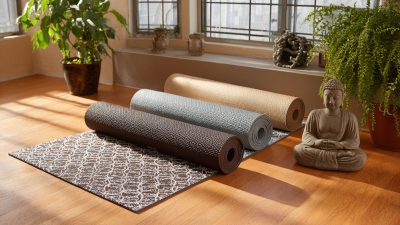12 Best Floor Matting For Room Ideas You Should Try Today
In recent years, the significance of choosing the right "Floor Matting For Room" has gained heightened attention among homeowners and interior designers alike. According to a report by Research and Markets, the global floor mat industry is projected to witness substantial growth, reaching approximately $5.58 billion by 2025, driven by increasing awareness of the importance of safety and hygiene in personal and professional spaces. The right floor matting not only enhances aesthetic appeal but also plays a crucial role in minimizing slip hazards, improving comfort, and reducing noise levels. As we delve into the 12 best floor matting ideas that you can implement today, it’s essential to consider how these innovative options can transform your rooms into safer, more stylish environments that cater to your unique needs.

Top 5 Benefits of Using Floor Mats: Enhancing Comfort and Safety in Your Home
Floor mats are not just decorative accents; they offer numerous benefits that enhance both comfort and safety in your home. According to a report by the International Journal of Occupational Safety and Ergonomics, slip and fall accidents account for nearly 20% of all workplace injuries, highlighting the importance of effective flooring solutions. By utilizing high-quality floor mats, homeowners can significantly reduce the risk of these accidents. Mats with textured surfaces can provide better grip, particularly in high-traffic areas such as entryways and kitchens, promoting a safer living environment.
In addition to safety, floor mats play a vital role in improving comfort. A study by the Ergonomics Society illustrates that standing for long periods on hard surfaces can lead to fatigue and discomfort. Floor mats designed with cushioning materials can alleviate these issues, offering support that encourages better posture and reduces strain. Furthermore, employing mats in various rooms can enhance thermal comfort; insulated mats can keep your feet warm in colder months, contributing to an overall inviting atmosphere in your home. As more homeowners recognize these advantages, the demand for specialized floor matting solutions continues to grow, underscoring the significant role they play in everyday living.
Benefits of Using Floor Mats in Your Home
Exploring Different Types of Floor Mats: A Guide to Material Selection for Every Room
When it comes to enhancing the comfort and aesthetics of our living spaces, the selection of floor mats plays a pivotal role. According to a recent industry report by Grand View Research, the global floor matting market is expected to reach $9.77 billion by 2025, driven by increasing demand in residential sectors. Choosing the right material for different rooms can significantly impact both style and functionality. For instance, plush carpets are ideal for bedrooms, providing warmth and softness underfoot, while anti-slip vinyl mats are perfect for kitchens and bathrooms due to their water-resistant properties and ease of cleaning.
Furthermore, natural fiber mats, such as jute and sisal, are gaining popularity among environmentally conscious consumers. The Sustainable Flooring Market Report highlights a 25% increase in demand for eco-friendly materials, reflecting a shift towards sustainable home decor. These materials not only add a rustic charm to any room but also provide durability and comfort. Whether you're looking to create a cozy reading nook or a vibrant playroom, understanding the material selection for floor mats can ensure that you choose options that suit your needs while also aligning with current interior design trends.
The Impact of Floor Mats on Indoor Air Quality: Statistics You Need to Know
When considering the importance of indoor air quality, floor mats play a surprisingly pivotal role. Research has shown that the surfaces we walk on can impact the air we breathe. For instance, studies indicate that over 60% of indoor air pollutants originate from outside, making it crucial to adopt strategies that can trap and reduce these toxins. High-quality floor mats can significantly minimize dirt, dust, and allergens that might otherwise circulate in a room. By placing mats at entry points and high-traffic areas, you can create a barrier that keeps these pollutants at bay and promotes a healthier living environment.

Moreover, the materials used in floor mats also contribute to their effectiveness in enhancing air quality. Mats made from natural fibers, for instance, can absorb moisture and prevent mold growth, which is essential in maintaining clean air. Some mats even come equipped with antimicrobial properties that inhibit the spread of bacteria and viruses. By choosing the right floor matting, you not only enhance the aesthetic of your space but also take an essential step towards improving your indoor air quality. Statistics suggest that using floor mats can lead to a reduction of up to 70% of dirt and moisture tracked into a building, underscoring their impact on maintaining a healthier indoor environment.
How to Choose the Right Floor Mat Size: Measurements That Matter for Aesthetic Appeal
When it comes to selecting the perfect floor mat for your room, understanding the right size is crucial for both functionality and aesthetic appeal. A well-sized mat can anchor a space, create balance, and enhance the overall design. Measuring your area correctly ensures that the mat complements your furniture and does not overwhelm the surrounding decor. For example, in a living room, a mat too small may get lost among larger furnishings, while a mat that is excessively large can disrupt the flow of the room.
According to recent market analyses, the global carpet and matting market is projected to grow from approximately $35.78 billion in 2025 to around $42.39 billion by 2033, showcasing an annual growth rate of 2.14%. This trend reflects a growing consumer interest in versatile and stylish flooring solutions. As more options become available, measuring your space accurately becomes even more vital. The right dimensions not only influence the feel of your room but also contribute to the longevity of the matting you choose, making the measurement process an important step in your design journey.
Trends in Eco-Friendly Floor Mats: Sustainable Options for Conscious Consumers
In recent years, the importance of sustainability has transformed the way consumers approach home decor, particularly in the realm of floor matting. Eco-friendly floor mats not only contribute to a greener planet but also elevate a room's aesthetic with their unique designs and natural materials. Brands are increasingly focusing on materials like jute, hemp, and recycled plastics, allowing consumers to make conscious choices without sacrificing style or comfort.

One standout trend in eco-friendly floor mats is the use of organic fibers, which are biodegradable and free from harmful chemicals. These mats often feature vibrant, earth-inspired colors and textures that bring warmth and character to any room. Additionally, some companies are innovating by creating mats from recycled materials, giving new life to waste products and reducing the environmental impact of traditional floor coverings. Embracing these sustainable options not only enhances your living space but also reflects a commitment to environmental responsibility, making them perfect for the modern, conscious consumer.
Related Posts
-

Innovative Solutions for Optimal Floor Matting in Every Room
-

Top Strategies for Choosing the Best Double Ribbed Floor Mat for Your Business
-

The Future of Double-Ribbed Floor Mats in Enhancing Workplace Safety and Efficiency
-

What are the Benefits of Choosing Layered Front Door Mats for Your Home
-

Exploring the Best Bath and Toilet Mat Set Options: A Comprehensive Comparison Guide
-

The Complete Handbook for Choosing Layered Front Door Mats for Your Home

